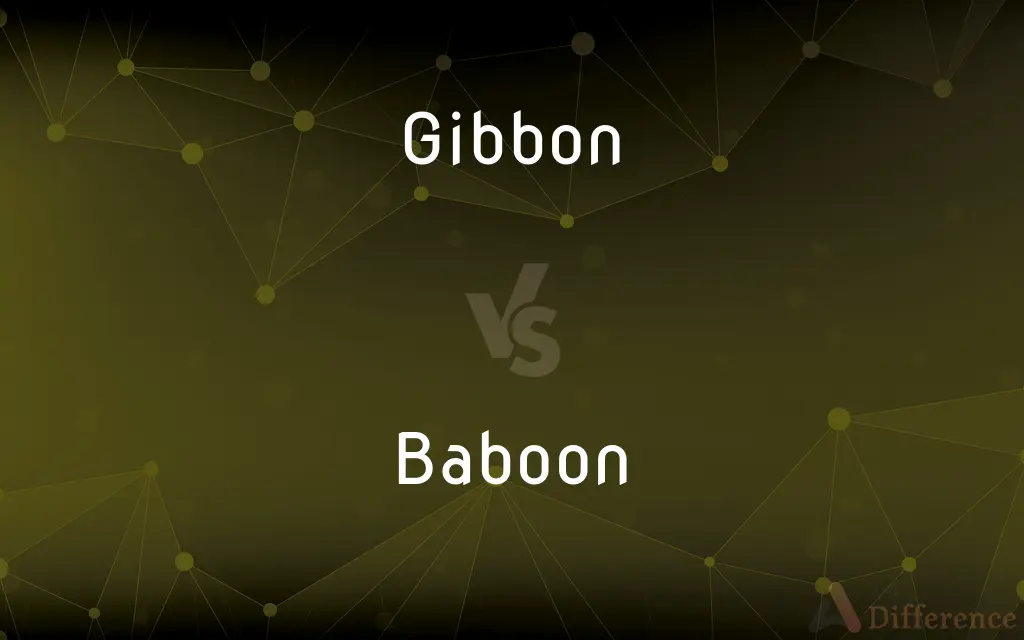Gibbon vs. Baboon — What's the Difference?
By Tayyaba Rehman — Updated on December 17, 2023
Gibbon is a small, arboreal ape known for its swinging motion; Baboon is a large, ground-dwelling monkey with a dog-like face and strong jaws.

Difference Between Gibbon and Baboon
Table of Contents
ADVERTISEMENT
Key Differences
Physical Characteristics: Gibbons are slender, tree-dwelling apes with long arms for brachiation, while baboons are robust, ground-dwelling monkeys with pronounced jaws and large canine teeth.
Habitat and Behavior: Gibbons inhabit dense forests in Asia and are arboreal, moving gracefully through trees. Baboons are found in various African environments and some parts of Arabia, and are more terrestrial, living on the ground.
Social Structure: Gibbons are known for their monogamous pairs and small family groups. In contrast, baboons live in large, complex social groups called troops.
Communication: Gibbons communicate through loud, melodious calls, often in duets, to mark territory and strengthen pair bonds. Baboons use a variety of vocalizations, body postures, and facial expressions for communication within their troops.
Diet: Both gibbons and baboons are omnivorous. Gibbons primarily consume fruits, leaves, and insects, while baboons have a more varied diet, including fruits, grasses, seeds, roots, and occasionally small animals.
ADVERTISEMENT
Comparison Chart
Size and Build
Smaller, slender with long arms
Larger, robust with strong jaws
Habitat
Arboreal, forest environments
Terrestrial, diverse environments
Social Organization
Monogamous pairs, small family groups
Large troops with complex hierarchies
Locomotion
Brachiation in trees
Ground dwelling, walking on all fours
Vocalization
Melodious calls for territory and bonding
Varied vocalizations for communication
Compare with Definitions
Gibbon
A gibbon is a small, arboreal ape known for its agility in trees.
The gibbon swung effortlessly from branch to branch.
Baboon
A baboon is a large, terrestrial monkey with a distinctive dog-like face.
The baboon foraged on the savanna floor.
Gibbon
Gibbons are renowned for their loud, melodious calls.
The forest echoed with the gibbon's call.
Baboon
Baboons live in large, complex social groups known as troops.
A troop of baboons gathered around the waterhole.
Gibbon
Gibbons are social animals, forming strong pair bonds.
A pair of gibbons sang together at dawn.
Baboon
Baboons have an omnivorous diet, including plants and small animals.
The baboon enjoyed both fruit and insects.
Gibbon
Many gibbon species are endangered due to habitat loss.
Conservationists are working to protect the endangered gibbon.
Baboon
Baboons are highly adaptive, living in varied environments.
Baboons thrive in both forests and arid regions.
Gibbon
Gibbons () are apes in the family Hylobatidae (). The family historically contained one genus, but now is split into four extant genera and 18 species.
Baboon
Baboons exhibit strong territorial behavior and hierarchy.
The alpha baboon guarded its territory fiercely.
Gibbon
Any of various small arboreal apes of the family Hylobatidae of Southeast Asia, having a slender body, long arms, and no tail.
Baboon
Baboons are primates comprising the genus Papio, one of the 23 genera of Old World monkeys. There are six species of baboon: the hamadryas baboon, the Guinea baboon, the olive baboon, the yellow baboon, the Kinda Baboon and the chacma baboon.
Gibbon
A small ape of the family Hylobatidae with long limbs, which it uses to travel through rainforests by swinging from branch to branch.
Baboon
Any of several large terrestrial African and Arabian monkeys of the genus Papio, having an elongated doglike muzzle and bare calluses on the buttocks.
Gibbon
Any arboreal ape of the genus Hylobates, of which many species and varieties inhabit the East Indies and Southern Asia. They are tailless and without cheek pouches, and have very long arms, adapted for climbing.
Baboon
(Slang) A brutish person; a boor.
Gibbon
English historian best known for his history of the Roman Empire (1737-1794)
Baboon
An Old World monkey of the genus Papio, having dog-like muzzles and large canine teeth, cheek pouches, a short tail, and naked callosities on the buttocks. 13
Gibbon
Smallest and most perfectly anthropoid arboreal ape having long arms and no tail; of southern Asia and East Indies
Baboon
A foolish or boorish person.
Gibbon
Gibbons are experts at brachiation, moving by swinging under branches.
The gibbon used brachiation to travel across the canopy.
Baboon
One of the Old World Quadrumana, of the genera Cynocephalus and Papio; the dog-faced ape. Baboons have dog-like muzzles and large canine teeth, cheek pouches, a short tail, and naked callosities on the buttocks. They are mostly African. See Mandrill, and Chacma, and Drill an ape.
Baboon
Large terrestrial monkeys having doglike muzzles
Common Curiosities
Where are gibbons naturally found?
Gibbons are native to the forests of Southeast Asia.
Do gibbons use tools?
Gibbons are not commonly known to use tools.
What distinguishes a gibbon from other apes?
Gibbons are smaller, arboreal, and known for their brachiation and singing.
What is a baboon's typical lifespan?
Baboons typically live for about 20-30 years.
What do baboons eat?
Baboons are omnivores, eating plants, insects, and small animals.
Are gibbons endangered?
Many gibbon species are endangered due to deforestation and hunting.
Can baboons be aggressive?
Baboons can be aggressive, especially when defending their territory or troop.
What are the main threats to baboons?
Main threats to baboons include habitat loss and hunting.
Do baboons have predators?
Baboons face threats from predators like leopards and lions.
How do gibbons communicate?
Gibbons communicate with loud calls and physical gestures.
What role do gibbons play in their ecosystem?
Gibbons are important for seed dispersal and maintaining forest health.
How do baboons socialize?
Baboons socialize in large troops with complex social structures.
Can gibbons swim?
Gibbons generally avoid water and are not known for swimming.
Are baboons found in Asia?
Baboons are primarily found in Africa, with one species in Arabia.
What is the gestation period of a gibbon?
The gestation period for a gibbon is about 7 months.
Share Your Discovery

Previous Comparison
Aperture vs. Orifice
Next Comparison
Defy vs. ResistAuthor Spotlight
Written by
Tayyaba RehmanTayyaba Rehman is a distinguished writer, currently serving as a primary contributor to askdifference.com. As a researcher in semantics and etymology, Tayyaba's passion for the complexity of languages and their distinctions has found a perfect home on the platform. Tayyaba delves into the intricacies of language, distinguishing between commonly confused words and phrases, thereby providing clarity for readers worldwide.














































